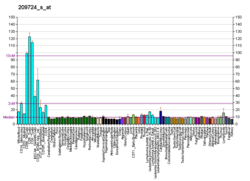| ZBTB14 |
|---|
|
| Identifiers |
|---|
| Aliases | ZBTB14, ZF5, ZFP-161, ZFP-5, ZFP161, ZNF478, zinc finger and BTB domain containing 14 |
|---|
| External IDs | OMIM: 602126; MGI: 1195345; HomoloGene: 2560; GeneCards: ZBTB14; OMA:ZBTB14 - orthologs |
|---|
| Gene location (Human) |
|---|
 | | Chr. | Chromosome 18 (human)[1] |
|---|
| | Band | 18p11.31 | Start | 5,289,019 bp[1] |
|---|
| End | 5,297,053 bp[1] |
|---|
|
| Gene location (Mouse) |
|---|
 | | Chr. | Chromosome 17 (mouse)[2] |
|---|
| | Band | 17 E1.3|17 40.42 cM | Start | 69,690,045 bp[2] |
|---|
| End | 69,698,194 bp[2] |
|---|
|
| RNA expression pattern |
|---|
| Bgee | | Human | Mouse (ortholog) |
|---|
| Top expressed in | - Achilles tendon
- lymph node
- monocyte
- granulocyte
- ganglionic eminence
- gallbladder
- ventricular zone
- C1 segment
- gonad
- rectum
|
| | Top expressed in | - ureter
- condyle
- Paneth cell
- ciliary body
- fossa
- medullary collecting duct
- lacrimal gland
- ascending aorta
- cumulus cell
- aortic valve
|
| | More reference expression data |
|
|---|
| BioGPS | 
 | | More reference expression data |
|
|---|
|
| Gene ontology |
|---|
| Molecular function | - DNA-binding transcription factor activity
- sequence-specific DNA binding
- DNA binding
- protein binding
- metal ion binding
- nucleic acid binding
- RNA polymerase II cis-regulatory region sequence-specific DNA binding
- DNA-binding transcription repressor activity, RNA polymerase II-specific
- DNA-binding transcription factor activity, RNA polymerase II-specific
| | Cellular component | - nucleus
- nucleoplasm
- nucleolus
- cytosol
- aggresome
| | Biological process | - cardiac septum development
- heart valve development
- negative regulation of transcription, DNA-templated
- regulation of transcription, DNA-templated
- coronary vasculature development
- transcription, DNA-templated
- negative regulation of transcription by RNA polymerase II
| | Sources:Amigo / QuickGO |
|
| Orthologs |
|---|
| Species | Human | Mouse |
|---|
| Entrez | | |
|---|
| Ensembl | | |
|---|
| UniProt | | |
|---|
| RefSeq (mRNA) | |
|---|
NM_003409
NM_001143823
NM_001243702
NM_001243704 |
| |
|---|
NM_009547
NM_001356282
NM_001356283 |
|
|---|
| RefSeq (protein) | |
|---|
NP_001137295
NP_001230631
NP_001230633
NP_003400 |
| |
|---|
NP_033573
NP_001343211
NP_001343212 |
|
|---|
| Location (UCSC) | Chr 18: 5.29 – 5.3 Mb | Chr 17: 69.69 – 69.7 Mb |
|---|
| PubMed search | [3] | [4] |
|---|
|
| Wikidata |
| View/Edit Human | View/Edit Mouse |
|



















